Dissertation: Forecasting Freight Rates in Ore Carrier Shipping Market
VerifiedAdded on 2022/12/21
|54
|14581
|1
Dissertation
AI Summary
This dissertation focuses on forecasting freight rates within the large ore carrier shipping market, examining the direct and indirect influences of demand and supply variables on freight rates and the overall freight market. The research employs multiple regression models and secondary data analysis using STATA to identify correlations between global economic conditions, seaborne cargo, and building production, while also considering the negative impact of transport costs and scrapping. The study includes a comprehensive literature review, an overview of market characteristics, and an assessment of factors affecting supply and demand. The research aims to assist market participants, such as charterers and brokers, in making informed investment decisions by providing insights into market dynamics and future freight rate predictions. The dissertation covers the history, problem statement, aims, research questions, scope, and definitions of key terms relevant to the study.
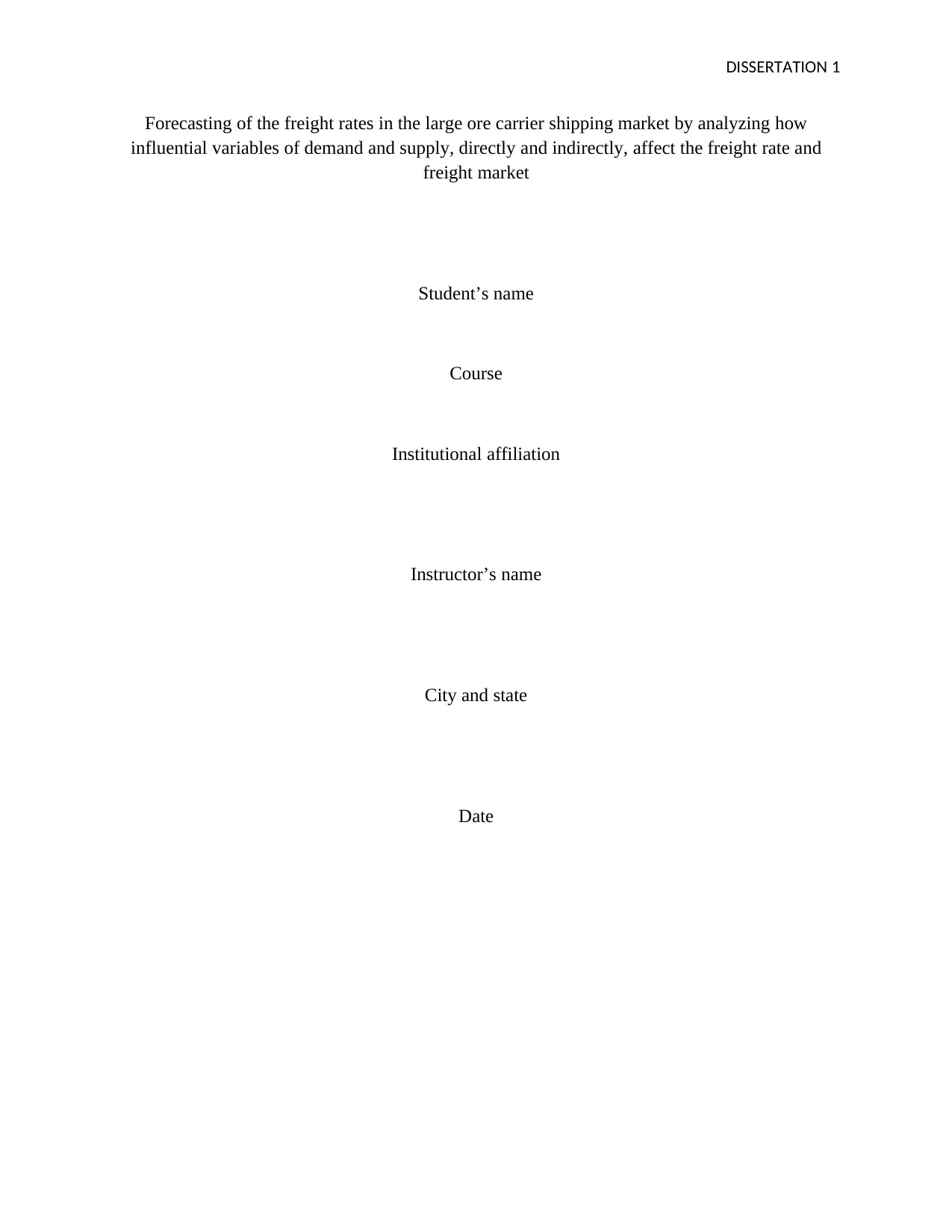
DISSERTATION 1
Forecasting of the freight rates in the large ore carrier shipping market by analyzing how
influential variables of demand and supply, directly and indirectly, affect the freight rate and
freight market
Student’s name
Course
Institutional affiliation
Instructor’s name
City and state
Date
Forecasting of the freight rates in the large ore carrier shipping market by analyzing how
influential variables of demand and supply, directly and indirectly, affect the freight rate and
freight market
Student’s name
Course
Institutional affiliation
Instructor’s name
City and state
Date
Paraphrase This Document
Need a fresh take? Get an instant paraphrase of this document with our AI Paraphraser
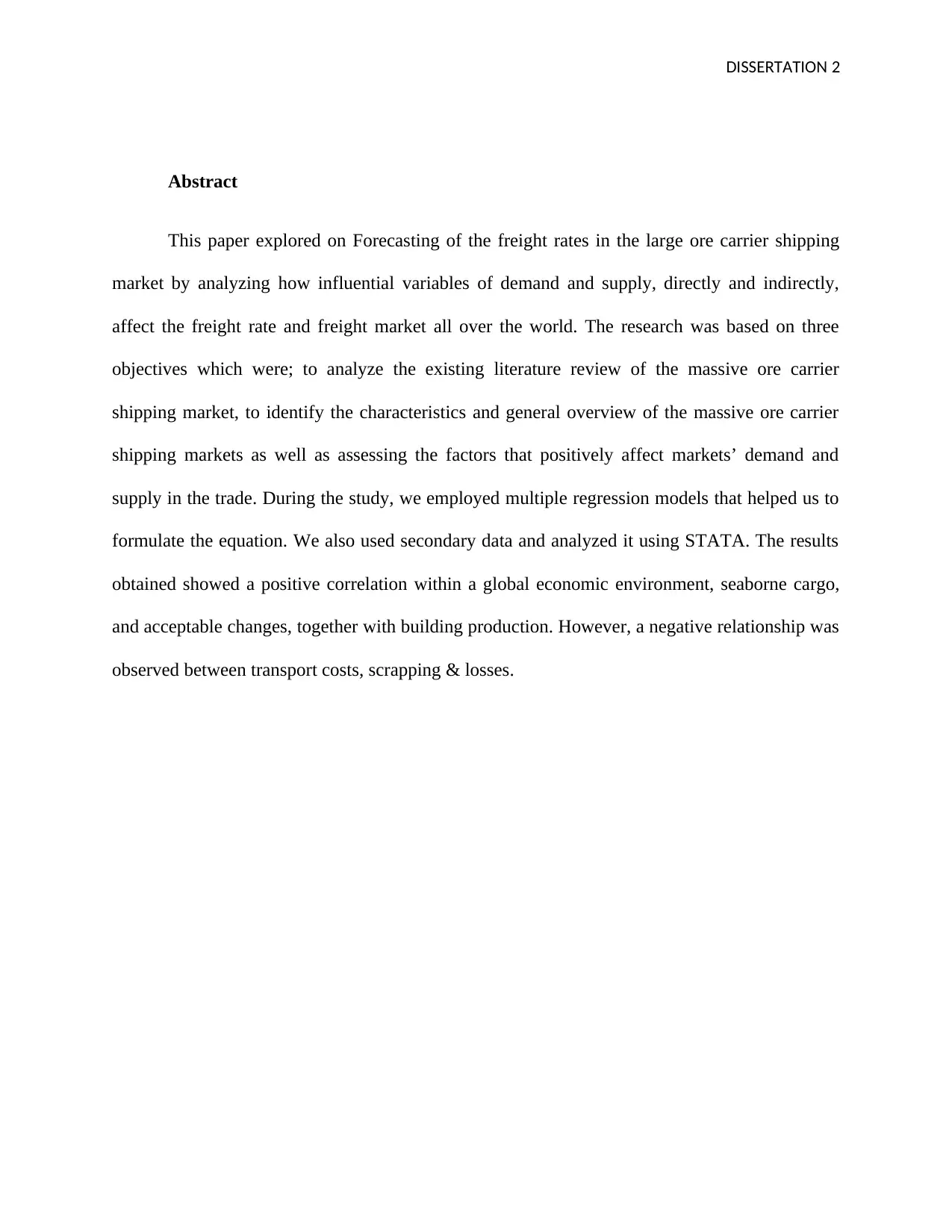
DISSERTATION 2
Abstract
This paper explored on Forecasting of the freight rates in the large ore carrier shipping
market by analyzing how influential variables of demand and supply, directly and indirectly,
affect the freight rate and freight market all over the world. The research was based on three
objectives which were; to analyze the existing literature review of the massive ore carrier
shipping market, to identify the characteristics and general overview of the massive ore carrier
shipping markets as well as assessing the factors that positively affect markets’ demand and
supply in the trade. During the study, we employed multiple regression models that helped us to
formulate the equation. We also used secondary data and analyzed it using STATA. The results
obtained showed a positive correlation within a global economic environment, seaborne cargo,
and acceptable changes, together with building production. However, a negative relationship was
observed between transport costs, scrapping & losses.
Abstract
This paper explored on Forecasting of the freight rates in the large ore carrier shipping
market by analyzing how influential variables of demand and supply, directly and indirectly,
affect the freight rate and freight market all over the world. The research was based on three
objectives which were; to analyze the existing literature review of the massive ore carrier
shipping market, to identify the characteristics and general overview of the massive ore carrier
shipping markets as well as assessing the factors that positively affect markets’ demand and
supply in the trade. During the study, we employed multiple regression models that helped us to
formulate the equation. We also used secondary data and analyzed it using STATA. The results
obtained showed a positive correlation within a global economic environment, seaborne cargo,
and acceptable changes, together with building production. However, a negative relationship was
observed between transport costs, scrapping & losses.
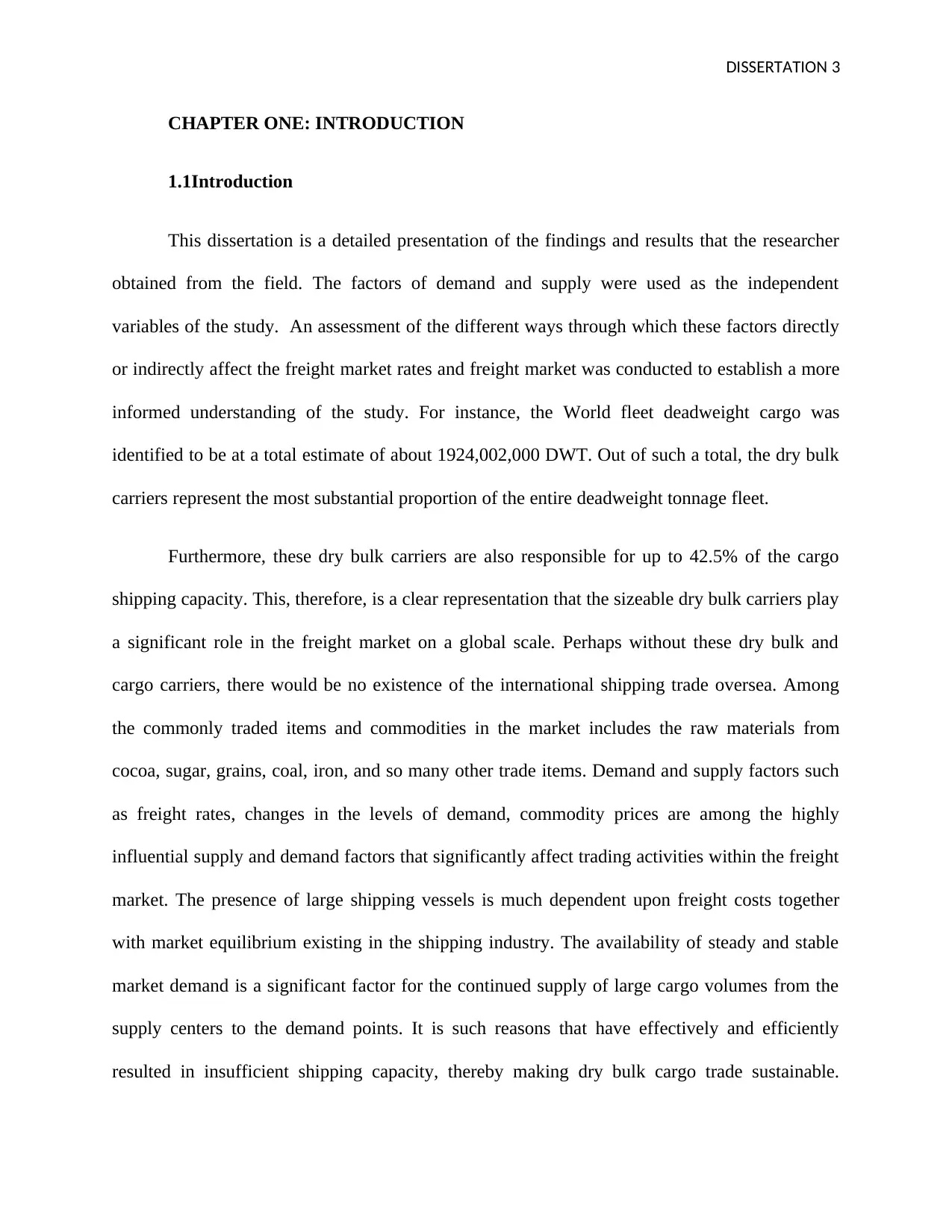
DISSERTATION 3
CHAPTER ONE: INTRODUCTION
1.1Introduction
This dissertation is a detailed presentation of the findings and results that the researcher
obtained from the field. The factors of demand and supply were used as the independent
variables of the study. An assessment of the different ways through which these factors directly
or indirectly affect the freight market rates and freight market was conducted to establish a more
informed understanding of the study. For instance, the World fleet deadweight cargo was
identified to be at a total estimate of about 1924,002,000 DWT. Out of such a total, the dry bulk
carriers represent the most substantial proportion of the entire deadweight tonnage fleet.
Furthermore, these dry bulk carriers are also responsible for up to 42.5% of the cargo
shipping capacity. This, therefore, is a clear representation that the sizeable dry bulk carriers play
a significant role in the freight market on a global scale. Perhaps without these dry bulk and
cargo carriers, there would be no existence of the international shipping trade oversea. Among
the commonly traded items and commodities in the market includes the raw materials from
cocoa, sugar, grains, coal, iron, and so many other trade items. Demand and supply factors such
as freight rates, changes in the levels of demand, commodity prices are among the highly
influential supply and demand factors that significantly affect trading activities within the freight
market. The presence of large shipping vessels is much dependent upon freight costs together
with market equilibrium existing in the shipping industry. The availability of steady and stable
market demand is a significant factor for the continued supply of large cargo volumes from the
supply centers to the demand points. It is such reasons that have effectively and efficiently
resulted in insufficient shipping capacity, thereby making dry bulk cargo trade sustainable.
CHAPTER ONE: INTRODUCTION
1.1Introduction
This dissertation is a detailed presentation of the findings and results that the researcher
obtained from the field. The factors of demand and supply were used as the independent
variables of the study. An assessment of the different ways through which these factors directly
or indirectly affect the freight market rates and freight market was conducted to establish a more
informed understanding of the study. For instance, the World fleet deadweight cargo was
identified to be at a total estimate of about 1924,002,000 DWT. Out of such a total, the dry bulk
carriers represent the most substantial proportion of the entire deadweight tonnage fleet.
Furthermore, these dry bulk carriers are also responsible for up to 42.5% of the cargo
shipping capacity. This, therefore, is a clear representation that the sizeable dry bulk carriers play
a significant role in the freight market on a global scale. Perhaps without these dry bulk and
cargo carriers, there would be no existence of the international shipping trade oversea. Among
the commonly traded items and commodities in the market includes the raw materials from
cocoa, sugar, grains, coal, iron, and so many other trade items. Demand and supply factors such
as freight rates, changes in the levels of demand, commodity prices are among the highly
influential supply and demand factors that significantly affect trading activities within the freight
market. The presence of large shipping vessels is much dependent upon freight costs together
with market equilibrium existing in the shipping industry. The availability of steady and stable
market demand is a significant factor for the continued supply of large cargo volumes from the
supply centers to the demand points. It is such reasons that have effectively and efficiently
resulted in insufficient shipping capacity, thereby making dry bulk cargo trade sustainable.
⊘ This is a preview!⊘
Do you want full access?
Subscribe today to unlock all pages.

Trusted by 1+ million students worldwide
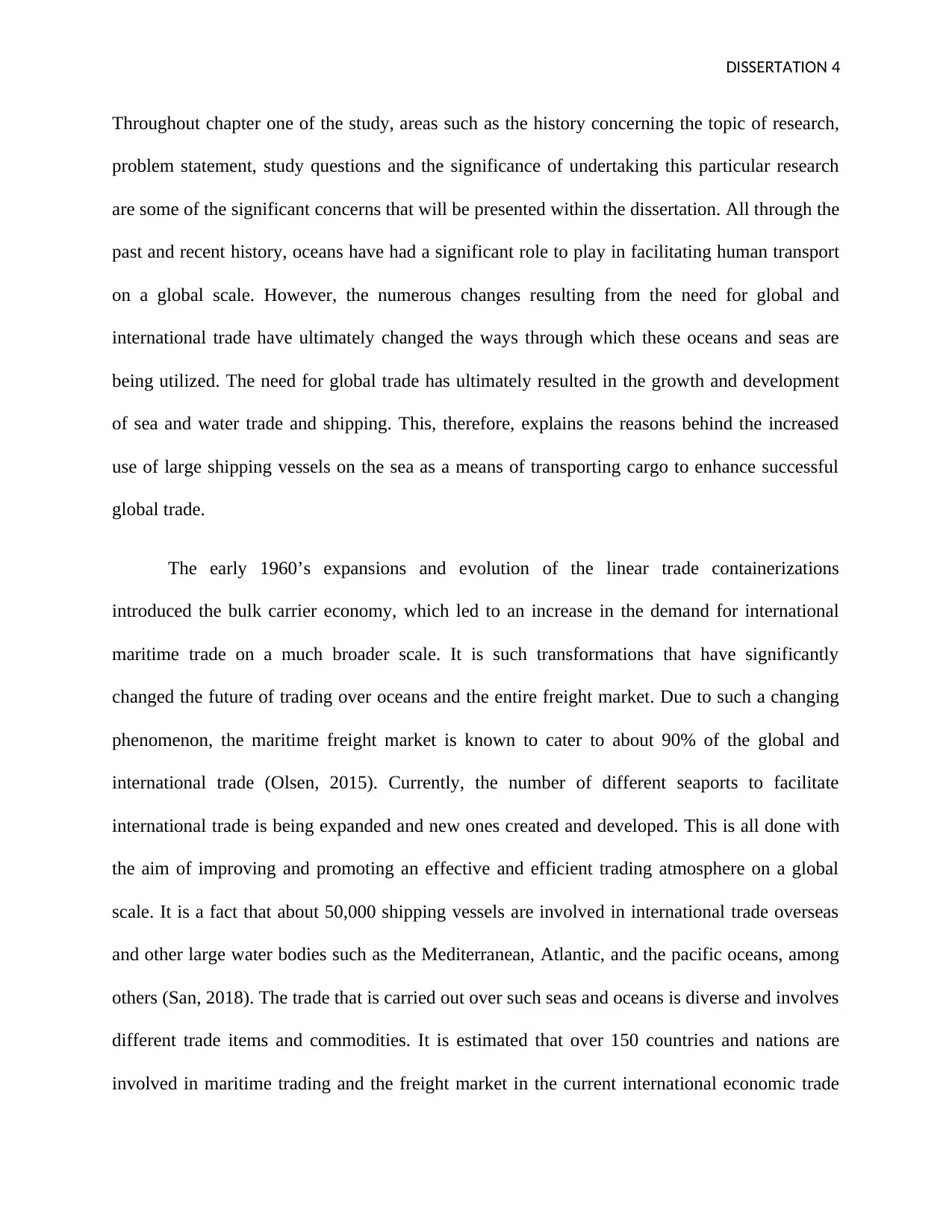
DISSERTATION 4
Throughout chapter one of the study, areas such as the history concerning the topic of research,
problem statement, study questions and the significance of undertaking this particular research
are some of the significant concerns that will be presented within the dissertation. All through the
past and recent history, oceans have had a significant role to play in facilitating human transport
on a global scale. However, the numerous changes resulting from the need for global and
international trade have ultimately changed the ways through which these oceans and seas are
being utilized. The need for global trade has ultimately resulted in the growth and development
of sea and water trade and shipping. This, therefore, explains the reasons behind the increased
use of large shipping vessels on the sea as a means of transporting cargo to enhance successful
global trade.
The early 1960’s expansions and evolution of the linear trade containerizations
introduced the bulk carrier economy, which led to an increase in the demand for international
maritime trade on a much broader scale. It is such transformations that have significantly
changed the future of trading over oceans and the entire freight market. Due to such a changing
phenomenon, the maritime freight market is known to cater to about 90% of the global and
international trade (Olsen, 2015). Currently, the number of different seaports to facilitate
international trade is being expanded and new ones created and developed. This is all done with
the aim of improving and promoting an effective and efficient trading atmosphere on a global
scale. It is a fact that about 50,000 shipping vessels are involved in international trade overseas
and other large water bodies such as the Mediterranean, Atlantic, and the pacific oceans, among
others (San, 2018). The trade that is carried out over such seas and oceans is diverse and involves
different trade items and commodities. It is estimated that over 150 countries and nations are
involved in maritime trading and the freight market in the current international economic trade
Throughout chapter one of the study, areas such as the history concerning the topic of research,
problem statement, study questions and the significance of undertaking this particular research
are some of the significant concerns that will be presented within the dissertation. All through the
past and recent history, oceans have had a significant role to play in facilitating human transport
on a global scale. However, the numerous changes resulting from the need for global and
international trade have ultimately changed the ways through which these oceans and seas are
being utilized. The need for global trade has ultimately resulted in the growth and development
of sea and water trade and shipping. This, therefore, explains the reasons behind the increased
use of large shipping vessels on the sea as a means of transporting cargo to enhance successful
global trade.
The early 1960’s expansions and evolution of the linear trade containerizations
introduced the bulk carrier economy, which led to an increase in the demand for international
maritime trade on a much broader scale. It is such transformations that have significantly
changed the future of trading over oceans and the entire freight market. Due to such a changing
phenomenon, the maritime freight market is known to cater to about 90% of the global and
international trade (Olsen, 2015). Currently, the number of different seaports to facilitate
international trade is being expanded and new ones created and developed. This is all done with
the aim of improving and promoting an effective and efficient trading atmosphere on a global
scale. It is a fact that about 50,000 shipping vessels are involved in international trade overseas
and other large water bodies such as the Mediterranean, Atlantic, and the pacific oceans, among
others (San, 2018). The trade that is carried out over such seas and oceans is diverse and involves
different trade items and commodities. It is estimated that over 150 countries and nations are
involved in maritime trading and the freight market in the current international economic trade
Paraphrase This Document
Need a fresh take? Get an instant paraphrase of this document with our AI Paraphraser
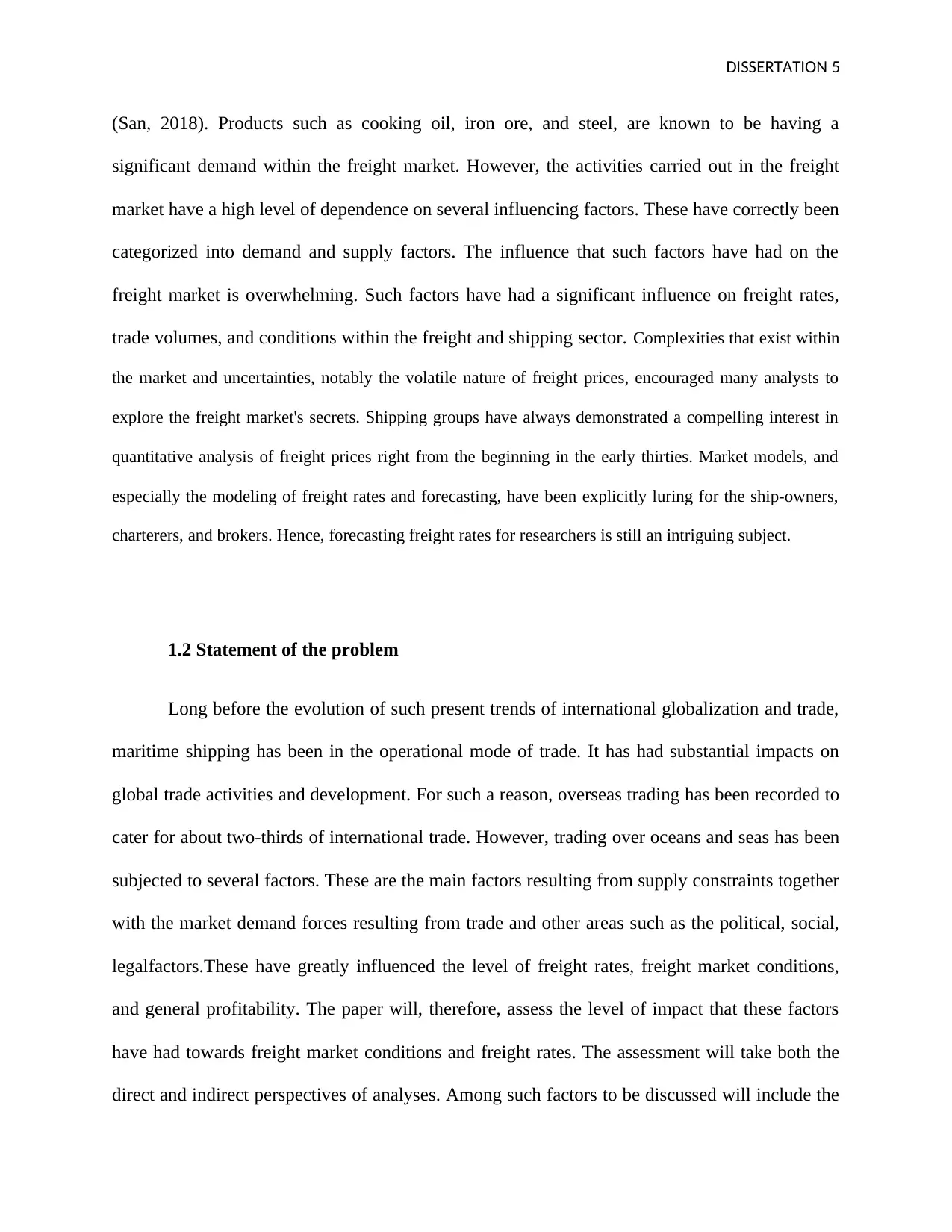
DISSERTATION 5
(San, 2018). Products such as cooking oil, iron ore, and steel, are known to be having a
significant demand within the freight market. However, the activities carried out in the freight
market have a high level of dependence on several influencing factors. These have correctly been
categorized into demand and supply factors. The influence that such factors have had on the
freight market is overwhelming. Such factors have had a significant influence on freight rates,
trade volumes, and conditions within the freight and shipping sector. Complexities that exist within
the market and uncertainties, notably the volatile nature of freight prices, encouraged many analysts to
explore the freight market's secrets. Shipping groups have always demonstrated a compelling interest in
quantitative analysis of freight prices right from the beginning in the early thirties. Market models, and
especially the modeling of freight rates and forecasting, have been explicitly luring for the ship-owners,
charterers, and brokers. Hence, forecasting freight rates for researchers is still an intriguing subject.
1.2 Statement of the problem
Long before the evolution of such present trends of international globalization and trade,
maritime shipping has been in the operational mode of trade. It has had substantial impacts on
global trade activities and development. For such a reason, overseas trading has been recorded to
cater for about two-thirds of international trade. However, trading over oceans and seas has been
subjected to several factors. These are the main factors resulting from supply constraints together
with the market demand forces resulting from trade and other areas such as the political, social,
legalfactors.These have greatly influenced the level of freight rates, freight market conditions,
and general profitability. The paper will, therefore, assess the level of impact that these factors
have had towards freight market conditions and freight rates. The assessment will take both the
direct and indirect perspectives of analyses. Among such factors to be discussed will include the
(San, 2018). Products such as cooking oil, iron ore, and steel, are known to be having a
significant demand within the freight market. However, the activities carried out in the freight
market have a high level of dependence on several influencing factors. These have correctly been
categorized into demand and supply factors. The influence that such factors have had on the
freight market is overwhelming. Such factors have had a significant influence on freight rates,
trade volumes, and conditions within the freight and shipping sector. Complexities that exist within
the market and uncertainties, notably the volatile nature of freight prices, encouraged many analysts to
explore the freight market's secrets. Shipping groups have always demonstrated a compelling interest in
quantitative analysis of freight prices right from the beginning in the early thirties. Market models, and
especially the modeling of freight rates and forecasting, have been explicitly luring for the ship-owners,
charterers, and brokers. Hence, forecasting freight rates for researchers is still an intriguing subject.
1.2 Statement of the problem
Long before the evolution of such present trends of international globalization and trade,
maritime shipping has been in the operational mode of trade. It has had substantial impacts on
global trade activities and development. For such a reason, overseas trading has been recorded to
cater for about two-thirds of international trade. However, trading over oceans and seas has been
subjected to several factors. These are the main factors resulting from supply constraints together
with the market demand forces resulting from trade and other areas such as the political, social,
legalfactors.These have greatly influenced the level of freight rates, freight market conditions,
and general profitability. The paper will, therefore, assess the level of impact that these factors
have had towards freight market conditions and freight rates. The assessment will take both the
direct and indirect perspectives of analyses. Among such factors to be discussed will include the
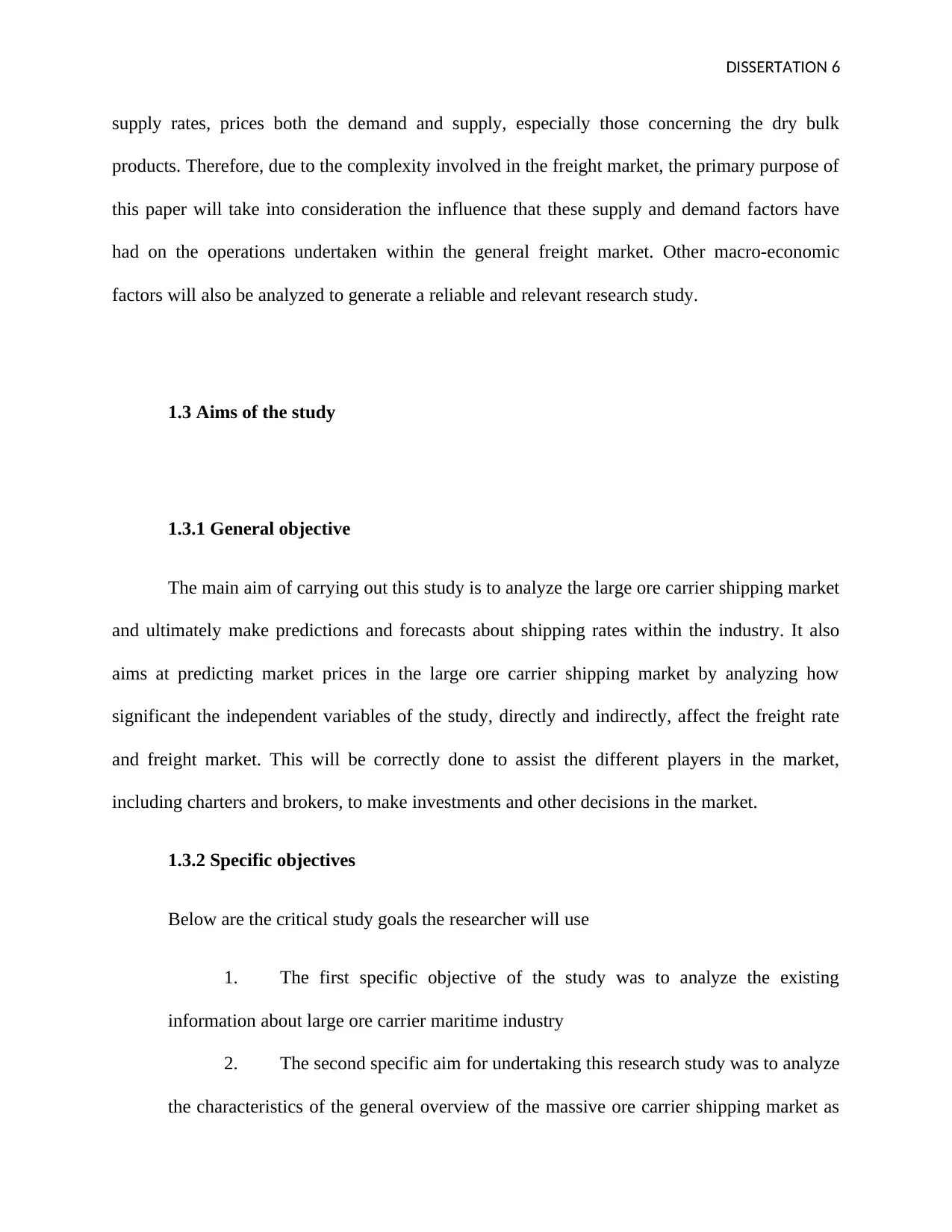
DISSERTATION 6
supply rates, prices both the demand and supply, especially those concerning the dry bulk
products. Therefore, due to the complexity involved in the freight market, the primary purpose of
this paper will take into consideration the influence that these supply and demand factors have
had on the operations undertaken within the general freight market. Other macro-economic
factors will also be analyzed to generate a reliable and relevant research study.
1.3 Aims of the study
1.3.1 General objective
The main aim of carrying out this study is to analyze the large ore carrier shipping market
and ultimately make predictions and forecasts about shipping rates within the industry. It also
aims at predicting market prices in the large ore carrier shipping market by analyzing how
significant the independent variables of the study, directly and indirectly, affect the freight rate
and freight market. This will be correctly done to assist the different players in the market,
including charters and brokers, to make investments and other decisions in the market.
1.3.2 Specific objectives
Below are the critical study goals the researcher will use
1. The first specific objective of the study was to analyze the existing
information about large ore carrier maritime industry
2. The second specific aim for undertaking this research study was to analyze
the characteristics of the general overview of the massive ore carrier shipping market as
supply rates, prices both the demand and supply, especially those concerning the dry bulk
products. Therefore, due to the complexity involved in the freight market, the primary purpose of
this paper will take into consideration the influence that these supply and demand factors have
had on the operations undertaken within the general freight market. Other macro-economic
factors will also be analyzed to generate a reliable and relevant research study.
1.3 Aims of the study
1.3.1 General objective
The main aim of carrying out this study is to analyze the large ore carrier shipping market
and ultimately make predictions and forecasts about shipping rates within the industry. It also
aims at predicting market prices in the large ore carrier shipping market by analyzing how
significant the independent variables of the study, directly and indirectly, affect the freight rate
and freight market. This will be correctly done to assist the different players in the market,
including charters and brokers, to make investments and other decisions in the market.
1.3.2 Specific objectives
Below are the critical study goals the researcher will use
1. The first specific objective of the study was to analyze the existing
information about large ore carrier maritime industry
2. The second specific aim for undertaking this research study was to analyze
the characteristics of the general overview of the massive ore carrier shipping market as
⊘ This is a preview!⊘
Do you want full access?
Subscribe today to unlock all pages.

Trusted by 1+ million students worldwide
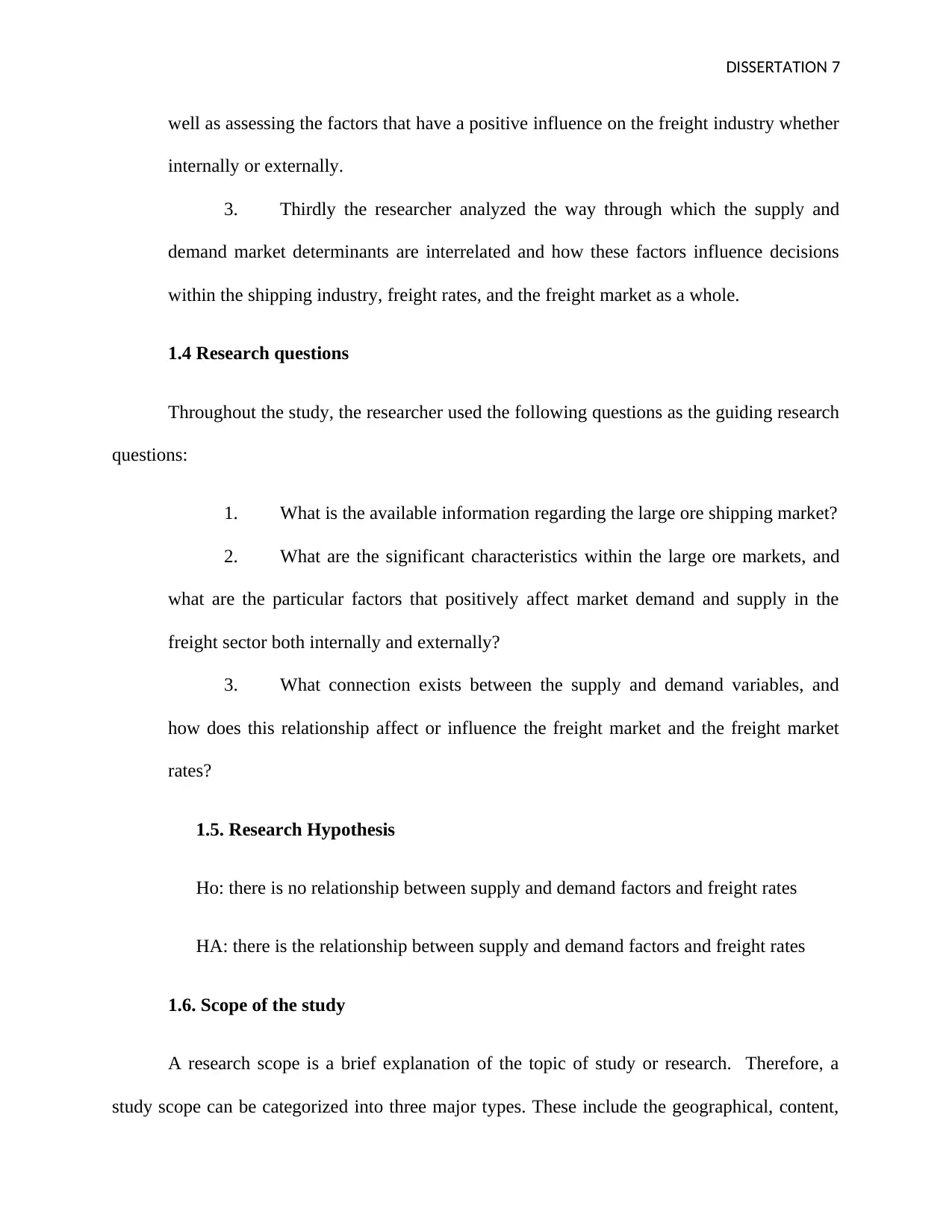
DISSERTATION 7
well as assessing the factors that have a positive influence on the freight industry whether
internally or externally.
3. Thirdly the researcher analyzed the way through which the supply and
demand market determinants are interrelated and how these factors influence decisions
within the shipping industry, freight rates, and the freight market as a whole.
1.4 Research questions
Throughout the study, the researcher used the following questions as the guiding research
questions:
1. What is the available information regarding the large ore shipping market?
2. What are the significant characteristics within the large ore markets, and
what are the particular factors that positively affect market demand and supply in the
freight sector both internally and externally?
3. What connection exists between the supply and demand variables, and
how does this relationship affect or influence the freight market and the freight market
rates?
1.5. Research Hypothesis
Ho: there is no relationship between supply and demand factors and freight rates
HA: there is the relationship between supply and demand factors and freight rates
1.6. Scope of the study
A research scope is a brief explanation of the topic of study or research. Therefore, a
study scope can be categorized into three major types. These include the geographical, content,
well as assessing the factors that have a positive influence on the freight industry whether
internally or externally.
3. Thirdly the researcher analyzed the way through which the supply and
demand market determinants are interrelated and how these factors influence decisions
within the shipping industry, freight rates, and the freight market as a whole.
1.4 Research questions
Throughout the study, the researcher used the following questions as the guiding research
questions:
1. What is the available information regarding the large ore shipping market?
2. What are the significant characteristics within the large ore markets, and
what are the particular factors that positively affect market demand and supply in the
freight sector both internally and externally?
3. What connection exists between the supply and demand variables, and
how does this relationship affect or influence the freight market and the freight market
rates?
1.5. Research Hypothesis
Ho: there is no relationship between supply and demand factors and freight rates
HA: there is the relationship between supply and demand factors and freight rates
1.6. Scope of the study
A research scope is a brief explanation of the topic of study or research. Therefore, a
study scope can be categorized into three major types. These include the geographical, content,
Paraphrase This Document
Need a fresh take? Get an instant paraphrase of this document with our AI Paraphraser
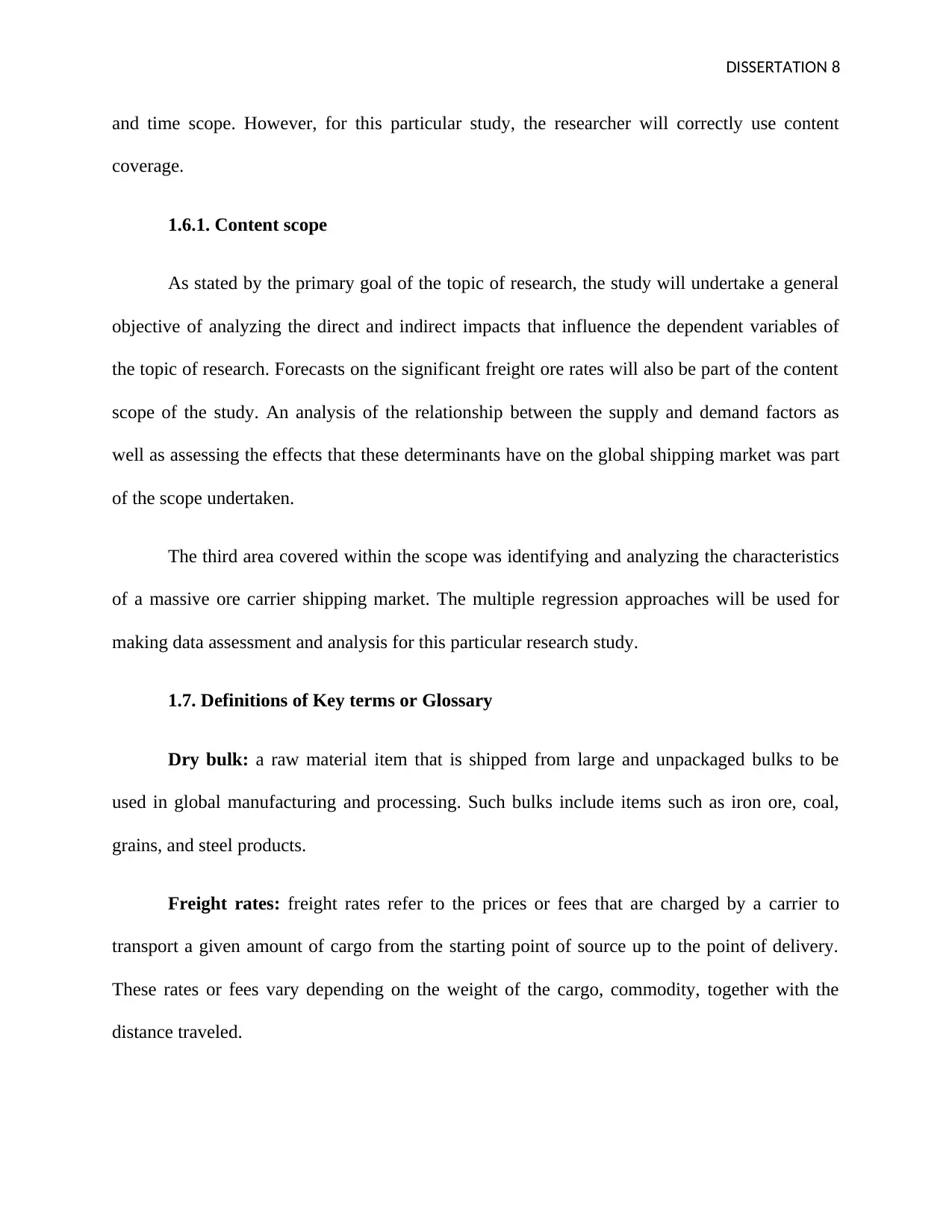
DISSERTATION 8
and time scope. However, for this particular study, the researcher will correctly use content
coverage.
1.6.1. Content scope
As stated by the primary goal of the topic of research, the study will undertake a general
objective of analyzing the direct and indirect impacts that influence the dependent variables of
the topic of research. Forecasts on the significant freight ore rates will also be part of the content
scope of the study. An analysis of the relationship between the supply and demand factors as
well as assessing the effects that these determinants have on the global shipping market was part
of the scope undertaken.
The third area covered within the scope was identifying and analyzing the characteristics
of a massive ore carrier shipping market. The multiple regression approaches will be used for
making data assessment and analysis for this particular research study.
1.7. Definitions of Key terms or Glossary
Dry bulk: a raw material item that is shipped from large and unpackaged bulks to be
used in global manufacturing and processing. Such bulks include items such as iron ore, coal,
grains, and steel products.
Freight rates: freight rates refer to the prices or fees that are charged by a carrier to
transport a given amount of cargo from the starting point of source up to the point of delivery.
These rates or fees vary depending on the weight of the cargo, commodity, together with the
distance traveled.
and time scope. However, for this particular study, the researcher will correctly use content
coverage.
1.6.1. Content scope
As stated by the primary goal of the topic of research, the study will undertake a general
objective of analyzing the direct and indirect impacts that influence the dependent variables of
the topic of research. Forecasts on the significant freight ore rates will also be part of the content
scope of the study. An analysis of the relationship between the supply and demand factors as
well as assessing the effects that these determinants have on the global shipping market was part
of the scope undertaken.
The third area covered within the scope was identifying and analyzing the characteristics
of a massive ore carrier shipping market. The multiple regression approaches will be used for
making data assessment and analysis for this particular research study.
1.7. Definitions of Key terms or Glossary
Dry bulk: a raw material item that is shipped from large and unpackaged bulks to be
used in global manufacturing and processing. Such bulks include items such as iron ore, coal,
grains, and steel products.
Freight rates: freight rates refer to the prices or fees that are charged by a carrier to
transport a given amount of cargo from the starting point of source up to the point of delivery.
These rates or fees vary depending on the weight of the cargo, commodity, together with the
distance traveled.
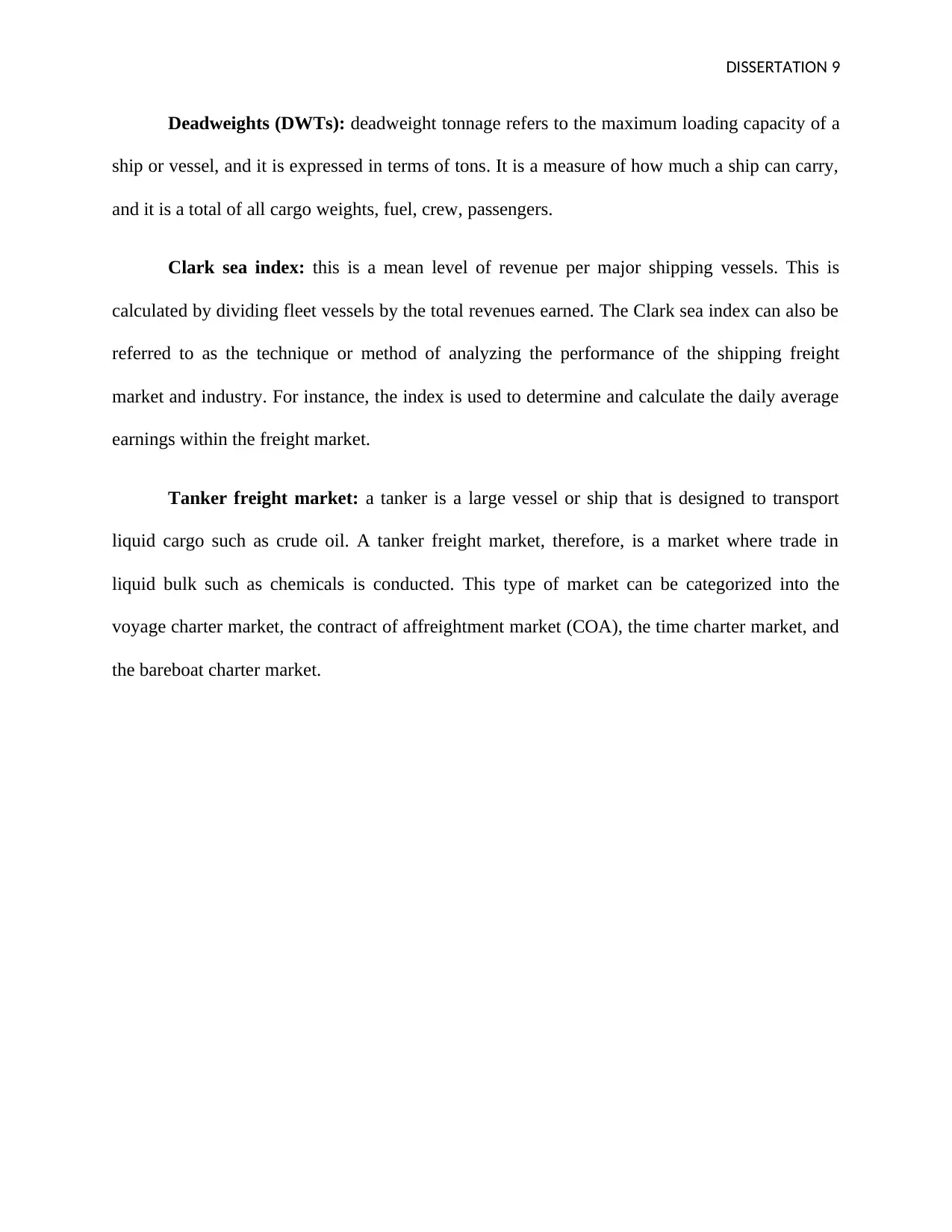
DISSERTATION 9
Deadweights (DWTs): deadweight tonnage refers to the maximum loading capacity of a
ship or vessel, and it is expressed in terms of tons. It is a measure of how much a ship can carry,
and it is a total of all cargo weights, fuel, crew, passengers.
Clark sea index: this is a mean level of revenue per major shipping vessels. This is
calculated by dividing fleet vessels by the total revenues earned. The Clark sea index can also be
referred to as the technique or method of analyzing the performance of the shipping freight
market and industry. For instance, the index is used to determine and calculate the daily average
earnings within the freight market.
Tanker freight market: a tanker is a large vessel or ship that is designed to transport
liquid cargo such as crude oil. A tanker freight market, therefore, is a market where trade in
liquid bulk such as chemicals is conducted. This type of market can be categorized into the
voyage charter market, the contract of affreightment market (COA), the time charter market, and
the bareboat charter market.
Deadweights (DWTs): deadweight tonnage refers to the maximum loading capacity of a
ship or vessel, and it is expressed in terms of tons. It is a measure of how much a ship can carry,
and it is a total of all cargo weights, fuel, crew, passengers.
Clark sea index: this is a mean level of revenue per major shipping vessels. This is
calculated by dividing fleet vessels by the total revenues earned. The Clark sea index can also be
referred to as the technique or method of analyzing the performance of the shipping freight
market and industry. For instance, the index is used to determine and calculate the daily average
earnings within the freight market.
Tanker freight market: a tanker is a large vessel or ship that is designed to transport
liquid cargo such as crude oil. A tanker freight market, therefore, is a market where trade in
liquid bulk such as chemicals is conducted. This type of market can be categorized into the
voyage charter market, the contract of affreightment market (COA), the time charter market, and
the bareboat charter market.
⊘ This is a preview!⊘
Do you want full access?
Subscribe today to unlock all pages.

Trusted by 1+ million students worldwide
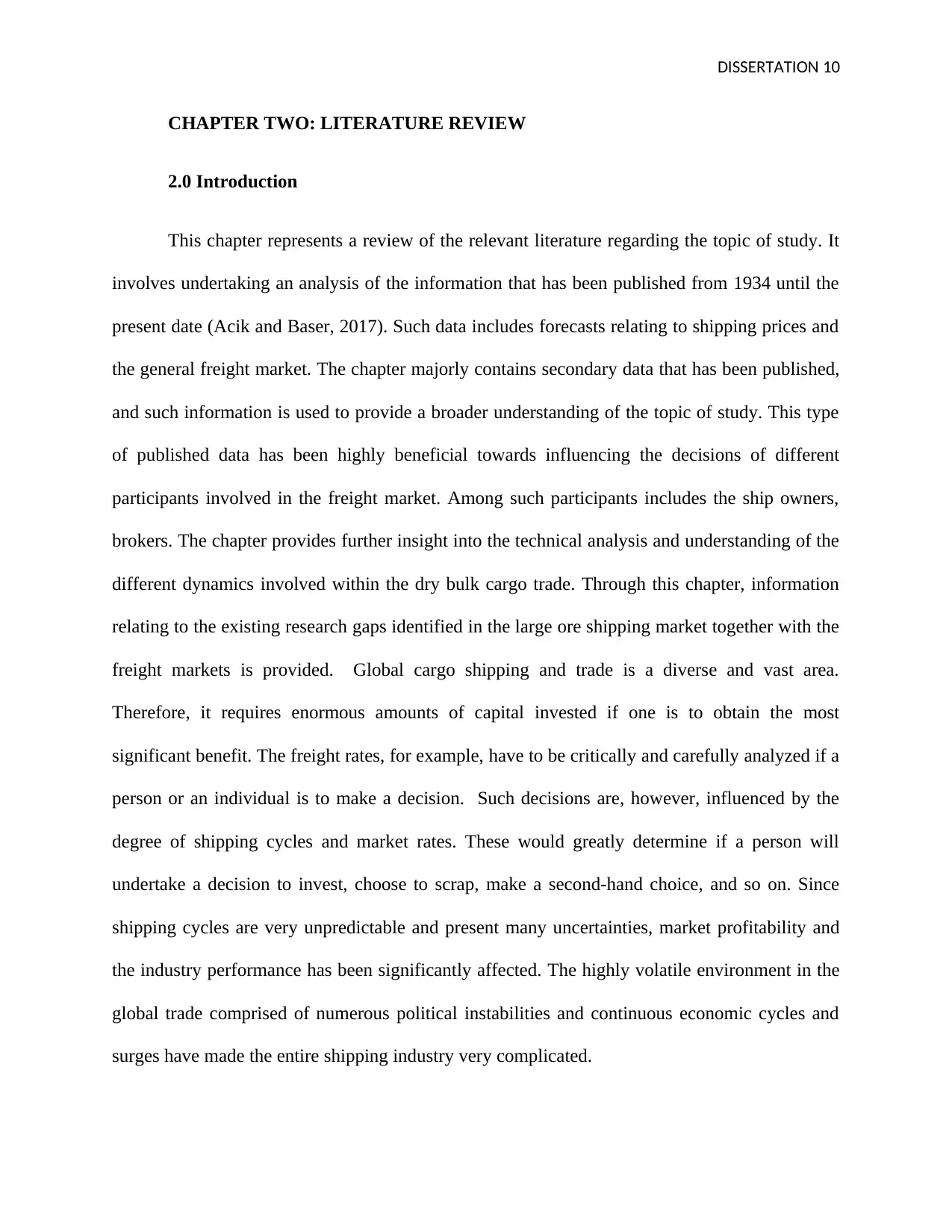
DISSERTATION 10
CHAPTER TWO: LITERATURE REVIEW
2.0 Introduction
This chapter represents a review of the relevant literature regarding the topic of study. It
involves undertaking an analysis of the information that has been published from 1934 until the
present date (Acik and Baser, 2017). Such data includes forecasts relating to shipping prices and
the general freight market. The chapter majorly contains secondary data that has been published,
and such information is used to provide a broader understanding of the topic of study. This type
of published data has been highly beneficial towards influencing the decisions of different
participants involved in the freight market. Among such participants includes the ship owners,
brokers. The chapter provides further insight into the technical analysis and understanding of the
different dynamics involved within the dry bulk cargo trade. Through this chapter, information
relating to the existing research gaps identified in the large ore shipping market together with the
freight markets is provided. Global cargo shipping and trade is a diverse and vast area.
Therefore, it requires enormous amounts of capital invested if one is to obtain the most
significant benefit. The freight rates, for example, have to be critically and carefully analyzed if a
person or an individual is to make a decision. Such decisions are, however, influenced by the
degree of shipping cycles and market rates. These would greatly determine if a person will
undertake a decision to invest, choose to scrap, make a second-hand choice, and so on. Since
shipping cycles are very unpredictable and present many uncertainties, market profitability and
the industry performance has been significantly affected. The highly volatile environment in the
global trade comprised of numerous political instabilities and continuous economic cycles and
surges have made the entire shipping industry very complicated.
CHAPTER TWO: LITERATURE REVIEW
2.0 Introduction
This chapter represents a review of the relevant literature regarding the topic of study. It
involves undertaking an analysis of the information that has been published from 1934 until the
present date (Acik and Baser, 2017). Such data includes forecasts relating to shipping prices and
the general freight market. The chapter majorly contains secondary data that has been published,
and such information is used to provide a broader understanding of the topic of study. This type
of published data has been highly beneficial towards influencing the decisions of different
participants involved in the freight market. Among such participants includes the ship owners,
brokers. The chapter provides further insight into the technical analysis and understanding of the
different dynamics involved within the dry bulk cargo trade. Through this chapter, information
relating to the existing research gaps identified in the large ore shipping market together with the
freight markets is provided. Global cargo shipping and trade is a diverse and vast area.
Therefore, it requires enormous amounts of capital invested if one is to obtain the most
significant benefit. The freight rates, for example, have to be critically and carefully analyzed if a
person or an individual is to make a decision. Such decisions are, however, influenced by the
degree of shipping cycles and market rates. These would greatly determine if a person will
undertake a decision to invest, choose to scrap, make a second-hand choice, and so on. Since
shipping cycles are very unpredictable and present many uncertainties, market profitability and
the industry performance has been significantly affected. The highly volatile environment in the
global trade comprised of numerous political instabilities and continuous economic cycles and
surges have made the entire shipping industry very complicated.
Paraphrase This Document
Need a fresh take? Get an instant paraphrase of this document with our AI Paraphraser
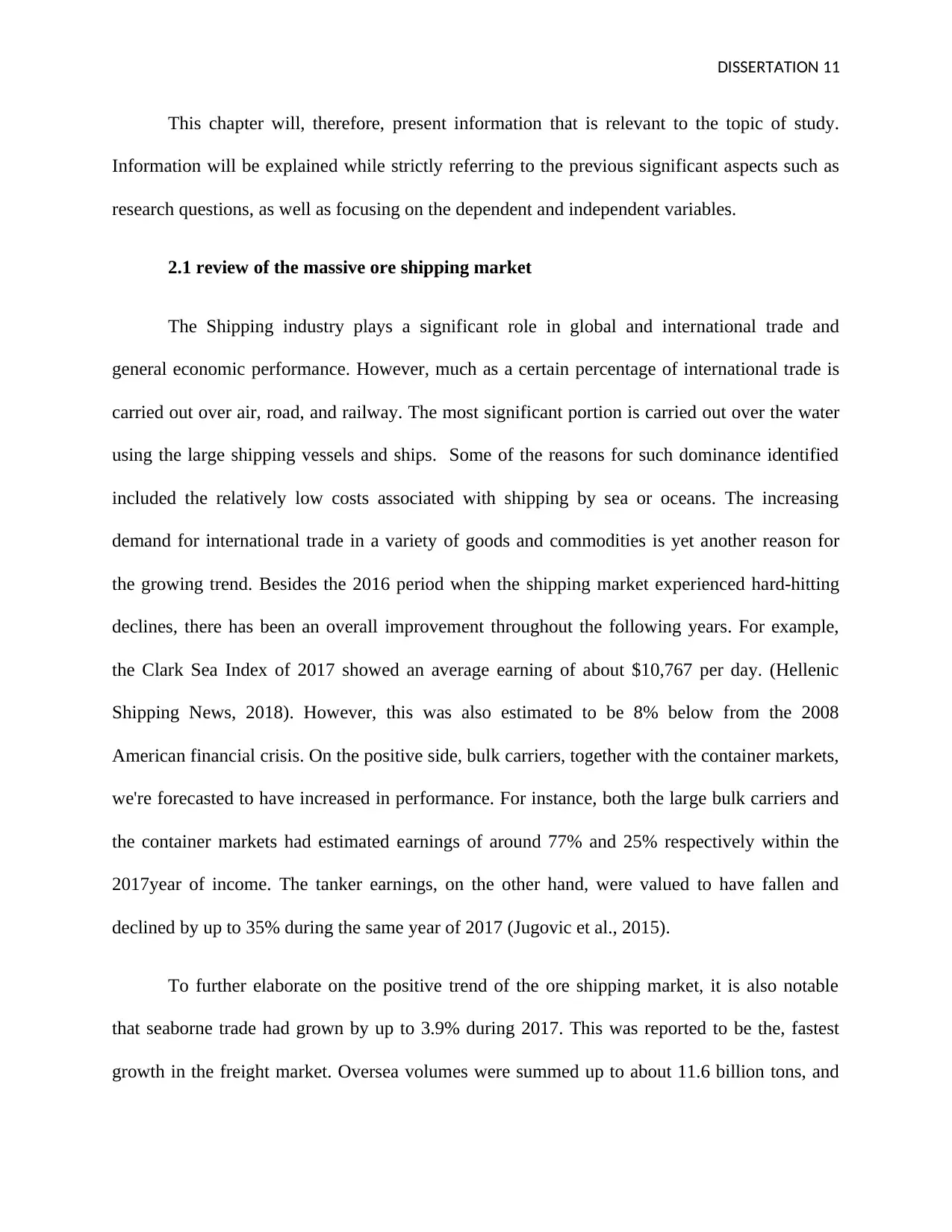
DISSERTATION 11
This chapter will, therefore, present information that is relevant to the topic of study.
Information will be explained while strictly referring to the previous significant aspects such as
research questions, as well as focusing on the dependent and independent variables.
2.1 review of the massive ore shipping market
The Shipping industry plays a significant role in global and international trade and
general economic performance. However, much as a certain percentage of international trade is
carried out over air, road, and railway. The most significant portion is carried out over the water
using the large shipping vessels and ships. Some of the reasons for such dominance identified
included the relatively low costs associated with shipping by sea or oceans. The increasing
demand for international trade in a variety of goods and commodities is yet another reason for
the growing trend. Besides the 2016 period when the shipping market experienced hard-hitting
declines, there has been an overall improvement throughout the following years. For example,
the Clark Sea Index of 2017 showed an average earning of about $10,767 per day. (Hellenic
Shipping News, 2018). However, this was also estimated to be 8% below from the 2008
American financial crisis. On the positive side, bulk carriers, together with the container markets,
we're forecasted to have increased in performance. For instance, both the large bulk carriers and
the container markets had estimated earnings of around 77% and 25% respectively within the
2017year of income. The tanker earnings, on the other hand, were valued to have fallen and
declined by up to 35% during the same year of 2017 (Jugovic et al., 2015).
To further elaborate on the positive trend of the ore shipping market, it is also notable
that seaborne trade had grown by up to 3.9% during 2017. This was reported to be the, fastest
growth in the freight market. Oversea volumes were summed up to about 11.6 billion tons, and
This chapter will, therefore, present information that is relevant to the topic of study.
Information will be explained while strictly referring to the previous significant aspects such as
research questions, as well as focusing on the dependent and independent variables.
2.1 review of the massive ore shipping market
The Shipping industry plays a significant role in global and international trade and
general economic performance. However, much as a certain percentage of international trade is
carried out over air, road, and railway. The most significant portion is carried out over the water
using the large shipping vessels and ships. Some of the reasons for such dominance identified
included the relatively low costs associated with shipping by sea or oceans. The increasing
demand for international trade in a variety of goods and commodities is yet another reason for
the growing trend. Besides the 2016 period when the shipping market experienced hard-hitting
declines, there has been an overall improvement throughout the following years. For example,
the Clark Sea Index of 2017 showed an average earning of about $10,767 per day. (Hellenic
Shipping News, 2018). However, this was also estimated to be 8% below from the 2008
American financial crisis. On the positive side, bulk carriers, together with the container markets,
we're forecasted to have increased in performance. For instance, both the large bulk carriers and
the container markets had estimated earnings of around 77% and 25% respectively within the
2017year of income. The tanker earnings, on the other hand, were valued to have fallen and
declined by up to 35% during the same year of 2017 (Jugovic et al., 2015).
To further elaborate on the positive trend of the ore shipping market, it is also notable
that seaborne trade had grown by up to 3.9% during 2017. This was reported to be the, fastest
growth in the freight market. Oversea volumes were summed up to about 11.6 billion tons, and
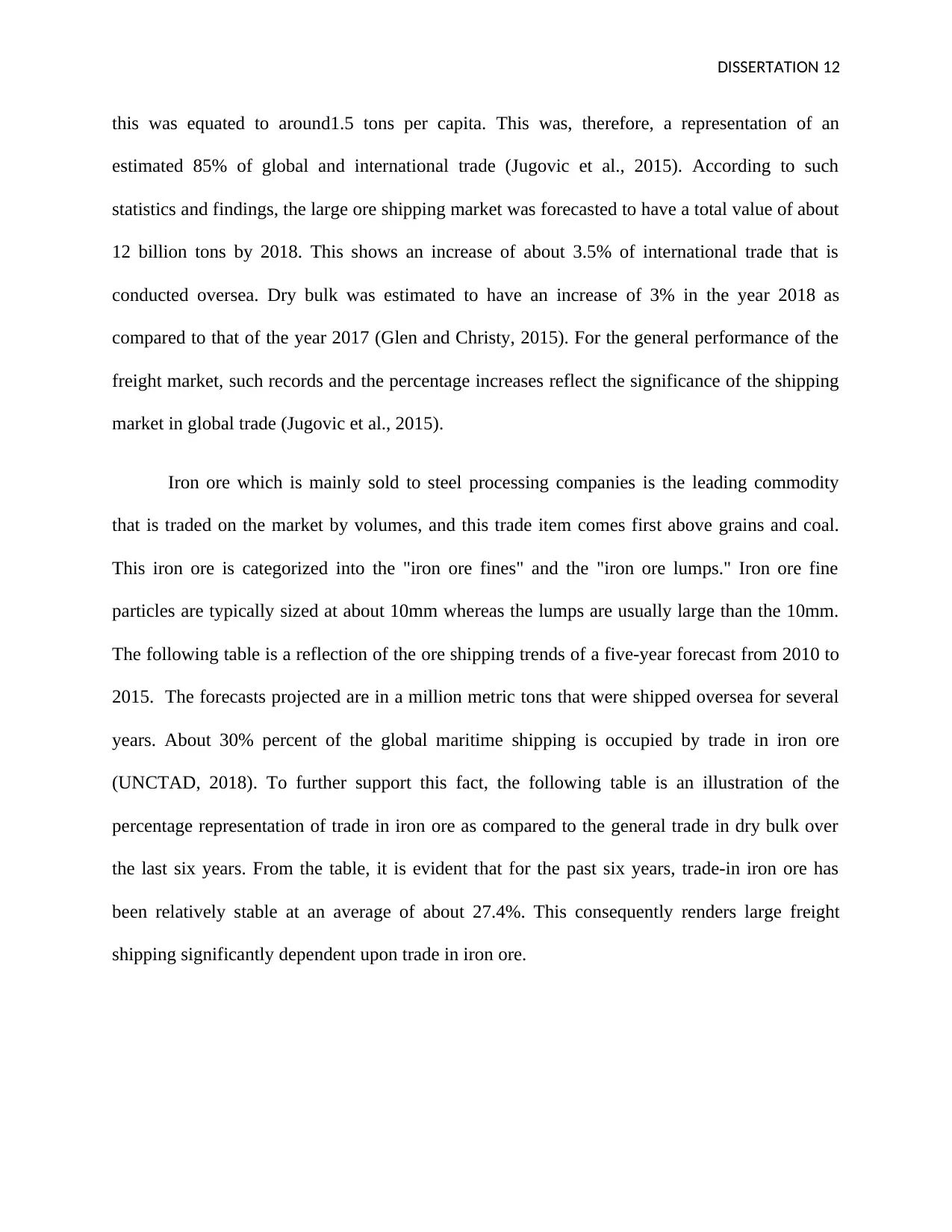
DISSERTATION 12
this was equated to around1.5 tons per capita. This was, therefore, a representation of an
estimated 85% of global and international trade (Jugovic et al., 2015). According to such
statistics and findings, the large ore shipping market was forecasted to have a total value of about
12 billion tons by 2018. This shows an increase of about 3.5% of international trade that is
conducted oversea. Dry bulk was estimated to have an increase of 3% in the year 2018 as
compared to that of the year 2017 (Glen and Christy, 2015). For the general performance of the
freight market, such records and the percentage increases reflect the significance of the shipping
market in global trade (Jugovic et al., 2015).
Iron ore which is mainly sold to steel processing companies is the leading commodity
that is traded on the market by volumes, and this trade item comes first above grains and coal.
This iron ore is categorized into the "iron ore fines" and the "iron ore lumps." Iron ore fine
particles are typically sized at about 10mm whereas the lumps are usually large than the 10mm.
The following table is a reflection of the ore shipping trends of a five-year forecast from 2010 to
2015. The forecasts projected are in a million metric tons that were shipped oversea for several
years. About 30% percent of the global maritime shipping is occupied by trade in iron ore
(UNCTAD, 2018). To further support this fact, the following table is an illustration of the
percentage representation of trade in iron ore as compared to the general trade in dry bulk over
the last six years. From the table, it is evident that for the past six years, trade-in iron ore has
been relatively stable at an average of about 27.4%. This consequently renders large freight
shipping significantly dependent upon trade in iron ore.
this was equated to around1.5 tons per capita. This was, therefore, a representation of an
estimated 85% of global and international trade (Jugovic et al., 2015). According to such
statistics and findings, the large ore shipping market was forecasted to have a total value of about
12 billion tons by 2018. This shows an increase of about 3.5% of international trade that is
conducted oversea. Dry bulk was estimated to have an increase of 3% in the year 2018 as
compared to that of the year 2017 (Glen and Christy, 2015). For the general performance of the
freight market, such records and the percentage increases reflect the significance of the shipping
market in global trade (Jugovic et al., 2015).
Iron ore which is mainly sold to steel processing companies is the leading commodity
that is traded on the market by volumes, and this trade item comes first above grains and coal.
This iron ore is categorized into the "iron ore fines" and the "iron ore lumps." Iron ore fine
particles are typically sized at about 10mm whereas the lumps are usually large than the 10mm.
The following table is a reflection of the ore shipping trends of a five-year forecast from 2010 to
2015. The forecasts projected are in a million metric tons that were shipped oversea for several
years. About 30% percent of the global maritime shipping is occupied by trade in iron ore
(UNCTAD, 2018). To further support this fact, the following table is an illustration of the
percentage representation of trade in iron ore as compared to the general trade in dry bulk over
the last six years. From the table, it is evident that for the past six years, trade-in iron ore has
been relatively stable at an average of about 27.4%. This consequently renders large freight
shipping significantly dependent upon trade in iron ore.
⊘ This is a preview!⊘
Do you want full access?
Subscribe today to unlock all pages.

Trusted by 1+ million students worldwide
1 out of 54
Related Documents
Your All-in-One AI-Powered Toolkit for Academic Success.
+13062052269
info@desklib.com
Available 24*7 on WhatsApp / Email
![[object Object]](/_next/static/media/star-bottom.7253800d.svg)
Unlock your academic potential
Copyright © 2020–2025 A2Z Services. All Rights Reserved. Developed and managed by ZUCOL.




